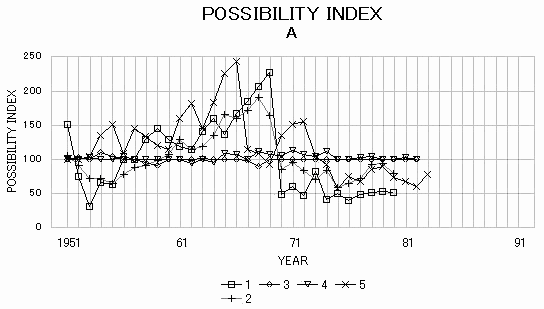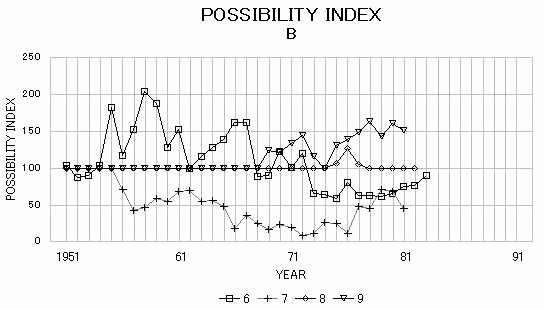|
Section I. INTRODUCTION
The topic of research and the basic contents
of each section are written. The topic is,
as the title shows, to formulate an practical
investment criterion. The research is focused
on the Indian economy, and so the investment
criterion was formulated with regard to the
Indian economy. The criterion was named ''Possibility
Index."
Section II. THEORETICAL FRAMEWORK
Theoretical framework is written. In sub-section 1,
some theories on investment decision are
surveyed. They are surveyed, especially,
with regard to the factors taken into account
and the determinant factor of investment.
Theories surveyed are the Capital-Turnover
Criterion, the Social Marginal Productivity
Criterion, the Reinvestment Criterion, the
Time Series Criterion, the Ratio of Labor
to Investment Criterion, the Balanced and
the Unbalanced Growth, the Cost-Benefit Analysis,
the theories on External Economies and Economies
of Scale, the Marginal Efficiency of Capital,
the Acceleration Principle, the Neoclassical
Theory, and the Tobin's q Theory.
In sub-section 2, the Possibility Index,
which is the topic of research, is explained.
It is a criterion aiming to raise the efficiency
of economy by investing the limited resources
into the sector of which the possibility
of growth is high as compared with the other
sectors. The possibility of growth is shown
as the ratio between the desired production
capacity and the actual production capacity.
The latter capacity is available from the
existing statistics but the former capacity
must be calculated. The way to calculate
the desired capacity is not specified here.
It is specified after analyzing all the data
available on the Indian economy.
In sub-section 3, the method of analysis
on the Indian and the Japanese economy is
explained. This analysis is to see how the
data available can reflect the possibility
of growth. Two economies are compared in
order to see the situation of investment
of both economies.
Section III. MANUFACTURING INDUSTRIES IN
INDIA
Selected 9 sectors of Indian manufacturing
industry are analyzed. Especially, they are
analyzed with regard to the output, production
capacity, capacity utilization, estimated
demand, exports and imports, availability
of raw materials, demand for and supply of
products, profitability, etc.
Section IV. MANUFACTURING INDUSTRIES IN JAPAN
Selected 5 sectors of Japanese manufacturing
industries are analyzed. They are analyzed
in the same way as the Indian industries
as far as possible.
Section V. FORMULATION OF THE INVESTMENT
CRITERION
The way to calculate the Possibility Index
is formulated.
In sub-section 1, the way to calculate
the Possibility Index is specified. And also
the way to calculate the desired capacity
is specified.
In sub-section 2, the desired capacity,
which is necessary to calculate the Possibility
Index, is calculated for 9 sectors selected.
In sub-section 3, the Possibility Index
is calculated and the result is examined.
In sub-section 4, necessary data to
calculate more accurately the Possibility
Index are specified while so far the Possibility
Index was calculated from the existing data.
These are the data which may be existing
or may not be existing but are technically
possible. And the way to calculate the Possibility
Index from these data are specified.
As written above, the Possibility Index is
calculated as follows.
DCAP
PI = --------- x 100
CAP
PI: Possibility Index
DCAP: desired production capacity
CAP: actual production capacity.
The Possibility Index was calculated for
following 9 sectors.
1 Diesel Engine Industry,
2 Radio Receiver Industry,
3 Cement Industry,
4 Soda Ash Industry,
5 Power Transformer Industry,
6 Electric Motor Industry,
7 Ceramic Insulator Industry (Low Tension),
8 Lead Industry,
9 Soap Industry.
The graphs of PI are shown at the end of
this summary.
Section VI. CONCLUSION
The conclusion is drawn. The merit of the
Possibility Index against the other investment
theories and criteria are examined. And,
the reliability and the future perspective
of the Possibility Index are examined.
APPENDICES
In sub-section 1, sources of data of
figures and notes for figures are collected.
In sub-section 2, figures are collected.
In sub-section 3, tables are collected.


PREVIOUS PAGE (Toshio Suzuki)
PREVIOUS PAGE (Japanese, Toshio Suzuki)
WORLD CITIZEN SITE (Site Guide)
|